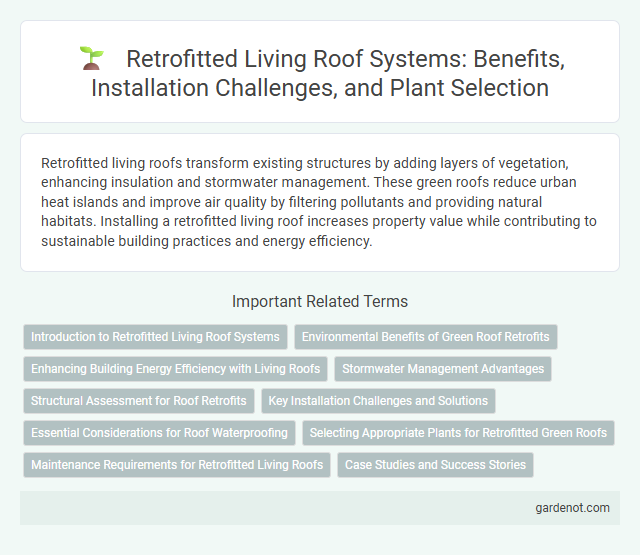Retrofitted living roofs transform existing structures by adding layers of vegetation, enhancing insulation and stormwater management. These green roofs reduce urban heat islands and improve air quality by filtering pollutants and providing natural habitats. Installing a retrofitted living roof increases property value while contributing to sustainable building practices and energy efficiency.
Introduction to Retrofitted Living Roof Systems
Retrofitted living roof systems transform existing building rooftops into sustainable green spaces that improve insulation, reduce stormwater runoff, and enhance urban biodiversity. These systems typically involve the installation of lightweight growing media, drought-tolerant vegetation, and advanced waterproofing layers to ensure structural integrity and long-term performance. Retrofitted green roofs contribute to energy savings by moderating indoor temperatures and mitigating the urban heat island effect in dense city environments.
Environmental Benefits of Green Roof Retrofits
Retrofitted living roofs significantly improve urban air quality by filtering pollutants and reducing airborne particulates. These green roof retrofits enhance stormwater management, decreasing runoff and mitigating flood risks in densely built environments. Energy efficiency is boosted as green roofs lower building temperatures, reducing the urban heat island effect and cutting cooling energy consumption.
Enhancing Building Energy Efficiency with Living Roofs
Retrofitted living roofs significantly enhance building energy efficiency by providing superior insulation and reducing heat transfer through the roof. These green roofs decrease cooling loads in summer and minimize heat loss during winter, lowering overall energy consumption. Incorporating drought-resistant vegetation and high-quality growing mediums optimizes thermal performance and extends roof lifespan.
Stormwater Management Advantages
Retrofitted living roofs significantly enhance stormwater management by reducing runoff volume and improving water retention, which mitigates urban flooding risks. These systems absorb and slowly release rainwater through the substrate and vegetation, decreasing peak stormwater discharge into drainage systems. Studies show retrofitted green roofs can retain up to 75% of annual rainfall, easing pressure on municipal stormwater infrastructure.
Structural Assessment for Roof Retrofits
Retrofitted living roofs require comprehensive structural assessment to ensure the existing roof can support additional load from soil, vegetation, and water retention systems. Engineers evaluate factors like load-bearing capacity, waterproofing integrity, and drainage to prevent structural failure and leaks. Accurate assessment minimizes risks and optimizes the design for sustainable green roof retrofit solutions.
Key Installation Challenges and Solutions
Retrofitting a living roof often requires addressing structural load limitations and ensuring adequate waterproofing to prevent leaks. Solutions include conducting detailed structural assessments and using lightweight growing mediums combined with advanced waterproof membranes. Proper drainage systems are installed to manage water retention and avoid root damage, ensuring long-term roof durability and plant health.
Essential Considerations for Roof Waterproofing
Retrofitted living roofs require careful attention to roof waterproofing to prevent water infiltration and structural damage. Key considerations include selecting high-quality, durable waterproof membranes compatible with existing roof materials and ensuring thorough sealing around penetrations and edges. Proper drainage systems must be integrated to manage water flow and avoid ponding, enhancing the overall longevity and effectiveness of the green roof.
Selecting Appropriate Plants for Retrofitted Green Roofs
Selecting appropriate plants for retrofitted green roofs requires focusing on species that can thrive in shallow substrates with limited water retention and high exposure to wind and sun. Succulents, sedums, and drought-tolerant native perennials are ideal choices due to their resilience and minimal maintenance needs. Proper plant selection enhances biodiversity, improves stormwater management, and ensures long-term sustainability of the retrofitted living roof system.
Maintenance Requirements for Retrofitted Living Roofs
Retrofitted living roofs require regular inspection to ensure proper drainage and prevent waterlogging, which can compromise structural integrity. Maintenance activities include debris removal, irrigation management during dry periods, and periodic fertilization to support vegetation health. Addressing issues such as weed control and repairing membrane damage promptly can extend the lifespan of retrofitted green roofs.
Case Studies and Success Stories
Retrofitted living roofs have transformed urban environments by enhancing insulation, reducing stormwater runoff, and improving air quality. In Toronto, the Evergreen Brick Works project demonstrated a 30% reduction in building energy consumption post-retrofit, showcasing the environmental and economic benefits of green roof installations. Numerous case studies from cities like Chicago and Berlin highlight increased biodiversity and extended roof lifespan, validating the success of living roof retrofitting strategies.
Retrofitted living roof Infographic

 gardenot.com
gardenot.com